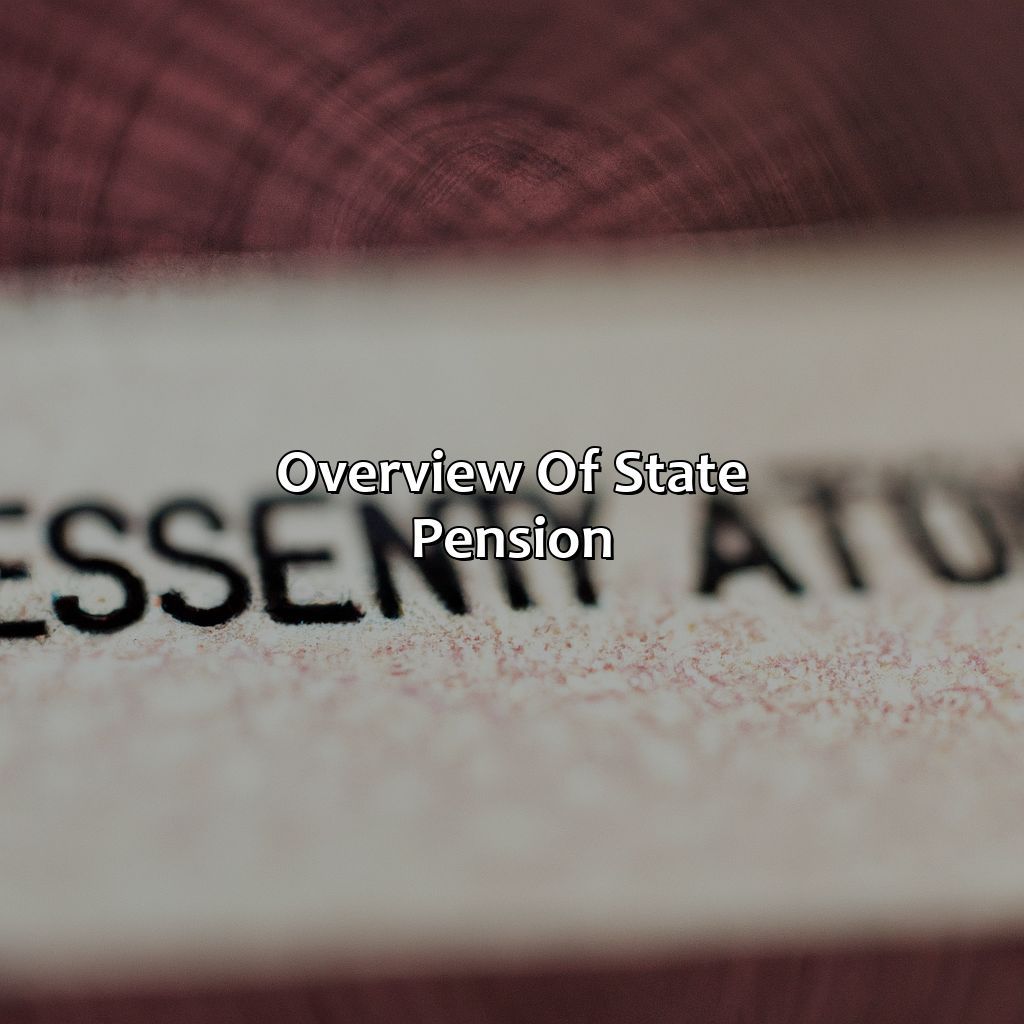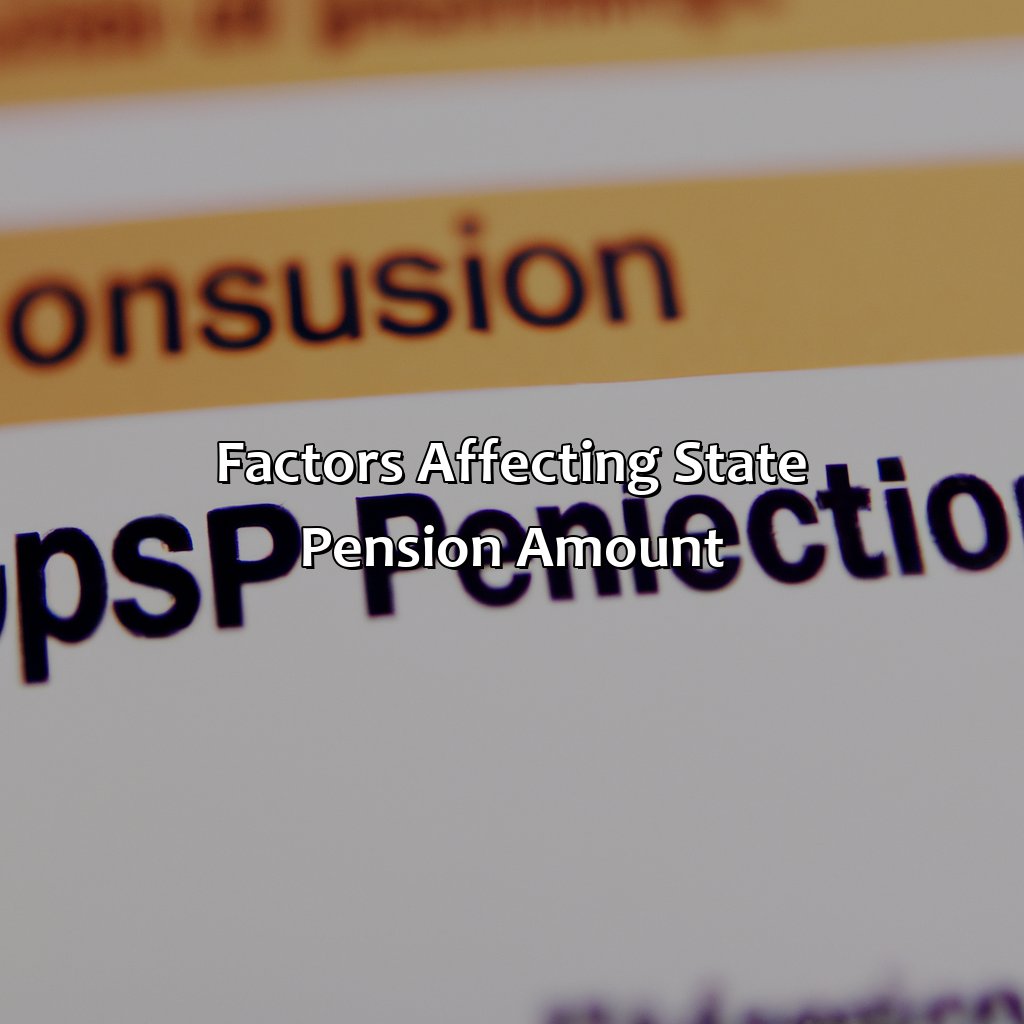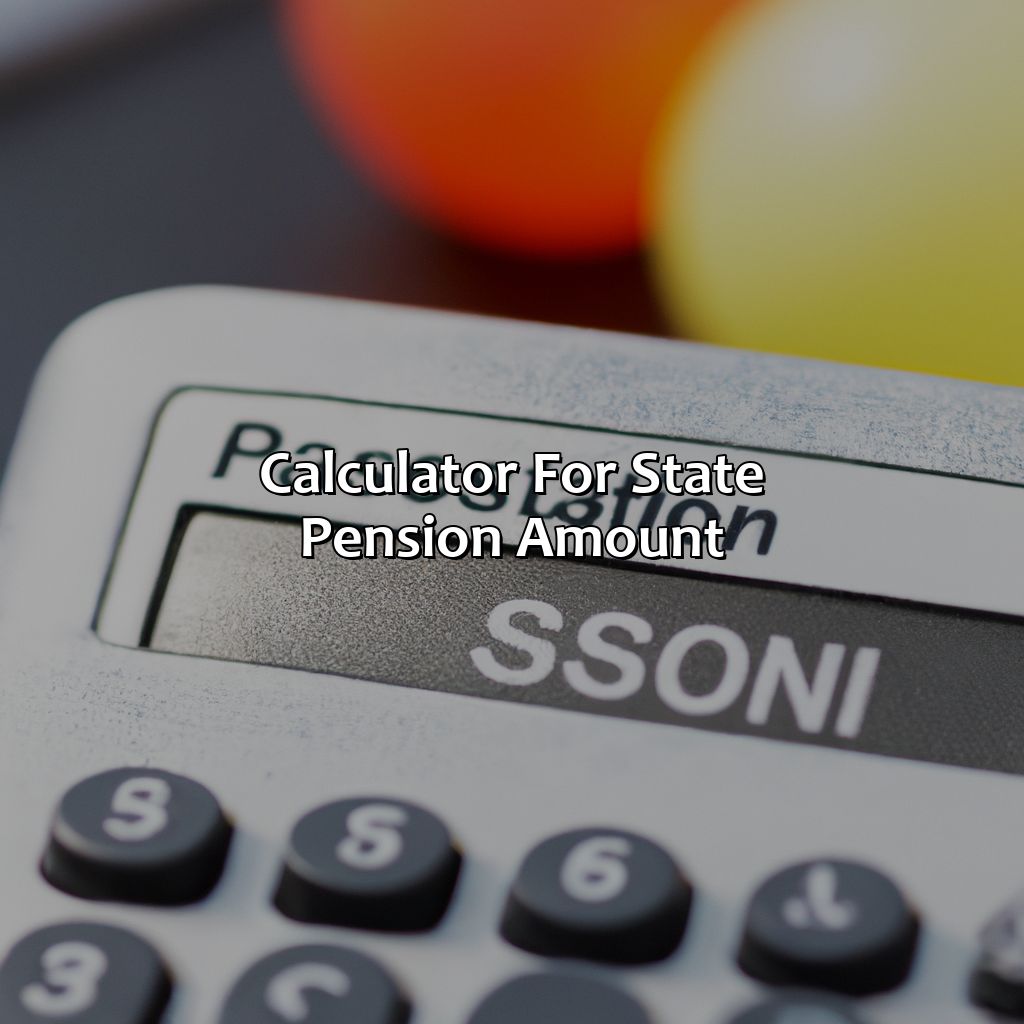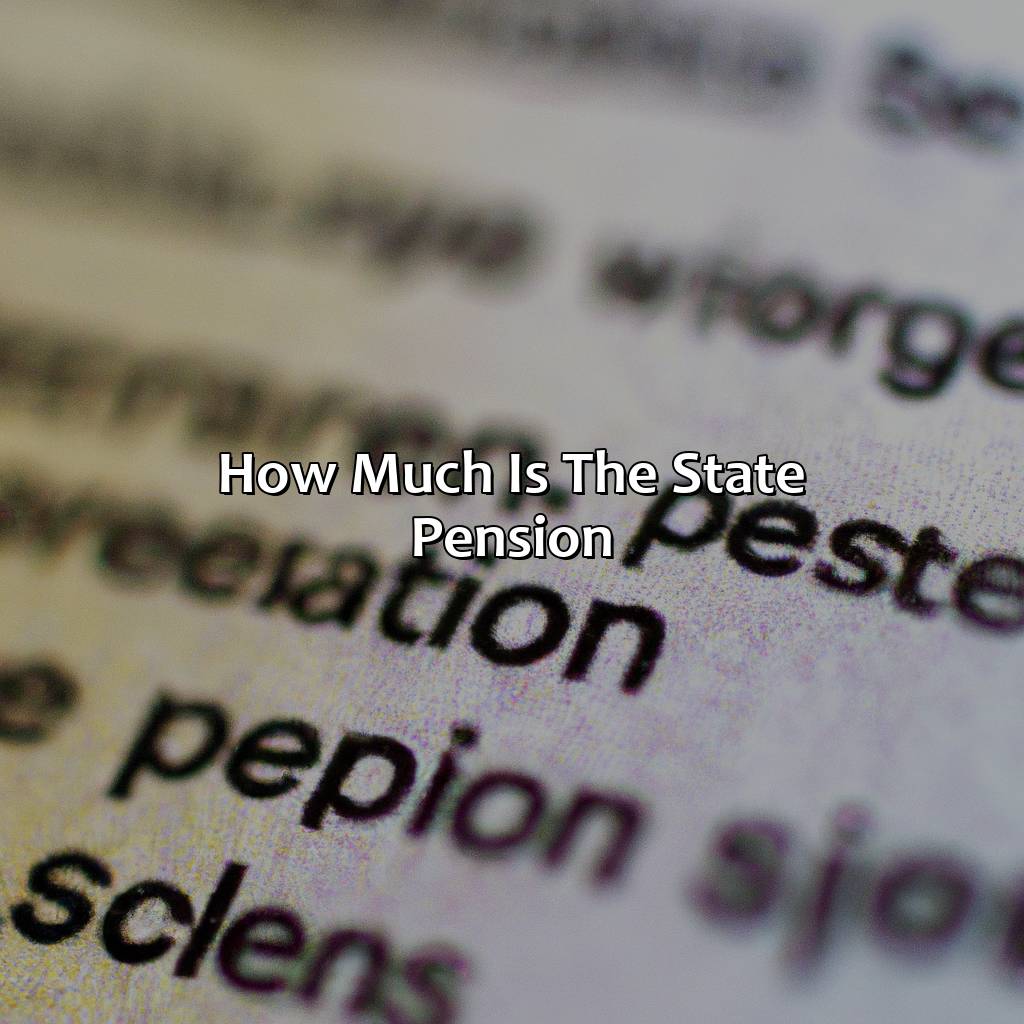How Much Is The State Pension?
Key Takeaway:
- The State Pension is a regular payment given by the government to those who have reached the retirement age and have made enough National Insurance contributions to qualify for it.
- The amount of State Pension depends on various factors, including the type of State Pension you are receiving, your National Insurance contributions, whether you have contracted out, and if you have deferred your State Pension.
- To estimate your State Pension amount, you can use a State Pension calculator, which takes into consideration your National Insurance contributions, other sources of retirement income, and allows you to plan accordingly.
Are you concerned about having enough money to live comfortably during retirement? Understanding the state pension can help you plan for the future. You can get the details on how much you are entitled to and how you can claim it. Learn how to maximize your retirement income here.
Overview of State Pension
Gain a complete understanding of state pension? This article offers an overview. It covers key info and essentials. Including the definition, eligibility criteria, and types of state pension. All you need to know!

Image credits: retiregenz.com by Yuval Washington
Definition of State Pension
State Pension is a payment given by the government to eligible citizens who have reached state pension age. It provides a basic income after retirement and helps support daily living expenses. The amount of State Pension received depends on various factors, including the recipient’s National Insurance contributions or credits, years of work history, and other applicable circumstances.
To determine how much State Pension one may receive, several factors need to be taken into account. These include assessing personal eligibility based on age, years of contributions or credits, and whether additional qualifying criteria are met. The current full new State Pension stands at 179.60 per week, but there may be adjustments that can reduce this amount for some individuals, such as those who opted out of paying National Insurance.
Moreover, it’s worth noting that the government may provide additional pension schemes beyond the basic State Pension; for example, occupational pensions or private pensions can complement or replace the State Pension scheme altogether. If you’re wondering how long a pension lasts, it depends on various factors such as the amount of contributions made and the terms and conditions of the pension plan.
Pro Tip: To stay up-to-date with any recent changes in State Pension policies and to learn more about available plans to supplement retirement income, consult official government websites regularly.
Do you meet the eligibility criteria for state pension? Well, it’s either that or winning the lottery at this point.
Eligibility Criteria for State Pension
To be eligible for State Pension, certain criteria must be met. These include fulfilling a minimum contribution threshold and reaching the State Pension age. The following points outline the eligibility requirements:
- Minimum of 10 qualifying years of National Insurance contributions.
- 35 qualifying years of National Insurance contributions for a full pension.
- Individuals who have reached the State Pension age on or after April 6, 2016, are eligible for the new State Pension.
- Individuals that have built up amounts under both the old and new schemes will receive an amount that includes both.
- Individuals who have paid Reduced Rate National Insurance Contributions due to having contracted out of the additional state pension may receive less than the full amount available under the new procedures.
It is noteworthy that individuals who defer claiming their State Pension can receive an increased weekly amount when they do start claiming it. Pro Tip: Keep track of your National Insurance contributions throughout your career to ensure you meet eligibility requirements for State Pension.
Get ready to learn about the different types of state pension, or as I like to call them, the ‘levels’ of retirement income.
Types of State Pension
State Pension – Different Variants
A detailed list of various types of state pensions are as follows:
If you are curious about how much is a widows pension, you can check out this article for more information.
Provided below are the different types of state pension programmes with their corresponding entitlement age:
| Type of State Pension | Entitlement Age |
|---|---|
| Basic State Pension | Men born before 6th April 1951. Women born before 6th April 1953 |
| New State Pension | Men born on/after 6th April 1951, Women born on/after 6th April 1953 |
In addition to these programs, a ‘Guaranteed Minimum Pension’ is provided to those individuals belonging to occupational pension schemes contracted out at any period between 1978 and 1997.
It is important to consider that the amount received in state pension varies based on the National Insurance contributions payed by an individual till retirement age. Ensure making regular contributions for maximum eligibility. Wondering how much is the retirement pension in Philippines? Click the link to find out more.
Pro Tip: Investigate private or workplace savings alternatives early in your career to supplement current or future retirement income.
Looks like the state pension won’t cover a luxury retirement, but hey, at least we’ll have enough to afford the basics…like bread and water.
State Pension Amount
You must know how much state pension you will get. To help you, here’s a short view on the state pension plans. These are:
- Basic State Pension
- Additional State Pension
- New State Pension

Image credits: retiregenz.com by Joel Duncun
Basic State Pension
This government-administered scheme provides a regular payment to qualifying individuals in their retirement age. The amount that one receives can vary depending on factors like National Insurance contributions, career earnings, and marital status. Therefore, the Basic Retirement Payment is not the same for every individual.
The Basic State Pension does not consider factors such as additional pensions or earnings applicable for a state pension top-up program.
It’s worth noting that before April 2016 and depending on age, men who’ve reached retirement age were able to receive an aged-pension while women required to meet different criteria dependent on their birth date. However, since implementing equalization changes gradually over several years since 2010, women who have recently reached retiral age now qualify for State Pension the same way men do.
Hope you’re not counting on the Additional State Pension to fund your retirement, because it’s about as reliable as British weather.
Additional State Pension
The State offers an Extra Payment option that allows for the addition of funds to one’s State Pension. This extra payment scheme was also known as SERPS. The amount paid is dependent upon an individual’s National Insurance contributions or credits. If you’re already eligible for the Basic State Pension, the Additional State Pension works as a top-up to increase it further.
The Additional State Pension is available to anyone who has made contributions towards their Basic State Pension, regardless of whether they are still working or have retired. The amount awarded depends on various criteria such as your earnings over your career and how much you contributed to the scheme through national insurance contributions. Additionally, if you were contracted out of the state pension at any point in your career, this will affect how much you can expect to receive from the Addtional State Pension.
It’s important to note that those who have used some money towards a defined benefit workplace pension probably did not qualify for the full additional state pension when they retire. It might be useful in these cases to contact the department of work and pensions who will help determine what amount will be added to their basic state pension through Extra Payments schemes like Additional State Pensions.
Looks like the new state pension is here to stay, and so are we… stuck working till we’re 107.
New State Pension
The State Pension provides a basic income to eligible individuals upon retirement, with the amount varying based on their National Insurance contributions.
The New State Pension, which was introduced in April 2016, has a full rate of 179.60 per week for those who qualify and have made at least 35 years of National Insurance contributions. However, the actual amount can be lower or higher depending on individual circumstances, such as contracting out of the Additional State Pension or receiving pension credit. It’s important to check your eligibility and estimated pension amount regularly to ensure you’re receiving what you’re entitled to.
Sorry to break it to you, but your pension amount is more influenced by your age and National Insurance contributions than your impressive collection of cat memes.
Factors Affecting State Pension Amount
Understand your state pension amount? Explore! National Insurance Contributions, Contracting Out and Deferring State Pension. All these impact the calculation of your pension. Knowing their effect is key for financial planning!

Image credits: retiregenz.com by Joel Washington
National Insurance Contributions
Contributions made towards the state pension are vital for determining the amount an individual will receive upon retirement age. The more an individual contributes to their national insurance, the higher their state pension amount is likely to be.
Additionally, depending on an individual’s employment status, they may have different contribution requirements. For example, self-employed individuals may have to contribute differently than a traditionally employed person.
It is important to note that there are also factors such as the number of qualifying years and any deductions which may affect the final state pension amount received.
Pro Tip: It is always worth checking your national insurance contributions history regularly to ensure you’re on track for receiving the full state pension amount.
Don’t get too excited about contracting out, the only thing you’ll be contracting is your retirement plans.
Contracting Out
For individuals in the United Kingdom, ‘Opting Out’ during the working years from SERPS or Second State Pension was a possibility. This decision is also known as ‘Contracting Out.’ Individuals that chose this option contributed to company pension plans instead of second state pension contributions.
Those who opted out will likely receive lower pensions than those who chose not to participate in second state pension post-retirement. The reason for the decrease is due to the elimination of some National Insurance Contributions or NICs and instead giving it to company pension plans, which provide an income after retirement.
It’s worth noting that this option was abolished from April 2016. All contracted-out deductions ceased on this date.
As per recent reports by Express UK, many women contractors have been unfairly hit by “contracting out.” By contrast, male employees are in a better position as they had fewer instances of transferring companies throughout their careers and mostly chose only higher-paying ones.
Why retire at 65 when you can postpone disappointment and enjoy your golden years at 70 with a bigger state pension?
Deferring State Pension
Delaying the Payment of State Pension
Delaying your pension could increase the amount you receive in the future. You can defer your state pension for a minimum of nine weeks and you ll get an increased payment of 1% for every nine weeks deferred. When does the state pension increase? It is possible to choose between receiving higher weekly payments or receiving a lump sum.
Deferring your state pension allows you to claim extra money later, and it takes effect from when you reach the state pension age. However, if you keep on working while deferring payment, you may still have to pay National Insurance contributions until full entitlement begins. Find out more about earning while claiming state pension.
In most cases, people who delay taking their state pensions usually get paid back through their life’s payment in benefits and have fewer fatalities. According to The Guardian, over 11 million people aged over 65 receive some kind of social security benefit as at Q4 2020.
Finally, a calculator that doesn’t require a degree in advanced mathematics just to figure out how much we’ll be living off of in our golden years.
Calculator for State Pension Amount
The State Pension Calculator is vital to know your state pension amount accurately. It’s easy to use and calculate your entitlement. To get the most out of it, you must understand its features. You can also get retirement income from other sources, but you need to use them alongside the State Pension Calculator.

Image credits: retiregenz.com by Joel Arnold
Importance of State Pension Calculator
The State Pension Calculator is an essential tool for individuals planning their post-retirement life. It enables individuals to calculate precisely how much pension they will receive from the government after the legal retirement age. By using this calculator, people can make informed decisions regarding their future finances and ensure that they are financially stable throughout their lives.
Understanding State Pension Calculator is crucial as it helps individuals customize their pension plan according to their needs. With this tool’s help, people can identify gaps in their pensions and take necessary measures to bridge them. This calculator also provides insights into various pension schemes available and advises beneficiaries on how to maximize returns.
It is important to note that the State Pension Calculator only provides an estimate of your pension amount and not the exact figure. Other factors such as National Insurance contributions and work history may affect one’s final pension benefits.
According to a recent survey by The Money Advice Service, over 90% of retirees have claimed the full state pensions they are entitled to. Therefore, using a reliable State Pension Calculator like the one provided by Gov.uk can significantly assist in maximizing one’s state pension benefits. Wondering what is the average pension for a nurse? Check our website for more information.
Using the state pension calculator is as easy as 1, 2, sigh, realizing retirement age keeps increasing.
How to Use State Pension Calculator
State Pension Calculation Guide: Discover How to Estimate Your Pension
The State Pension Calculator is an essential tool that allows you to estimate your State Pension amount. By using the calculator, you can gain insight into the money you will receive from the government upon retirement based on your national insurance contributions. If you’re wondering how much you can earn while on Pension Credit, the calculator can also give you an idea of the earnings threshold.
Here’s a step-by-step guide for how to use the State Pension Calculator:
- 1. you need to visit the government website
- Once you enter the site, find and click on “Check your State Pension”
- To continue, enter your basic personal data – your gender and birth date.
- After entering all of this information, you will see an estimated pension amount.
It is important to note that other factors that affect your final pension amount include whether or not you’ve received certain benefits and credits throughout your career.
Additionally, suppose some corrections are needed in terms of personal information or contribution records. In that case, a user might need to contact HMRC (Her Majesty’s Revenue & Customs).
A real-life example of how crucial it is to use such tools correctly could be Lizzy’s story. Lizzy was a school teacher who didn’t realize she hadn’t paid enough NICs due to her system administrator incorrectly classifying their payments over two decades ago. The State Pension Calculator highlighted this error and enabled Lizzy to adjust her debt accordingly before retirement.
Who needs retirement income sources when you can just live off your dark sense of humour?
Other Retirement Income Sources
When planning for retirement, it is important to consider all potential sources of income. Apart from the state pension, other retirement income sources can be valuable in providing a comfortable retirement. These sources may include employer pensions, personal savings and investments.
In addition to these common sources, there are other options to consider like rental property income, home equity conversion plans or part-time work. Whatever option you choose, it is essential to determine your expected income from each stream and how they will impact your overall financial picture during retirement.
It’s important to remember that each source of income comes with its unique taxation rules and regulations. Therefore, effective management of taxes can play a crucial role in maximizing retirement income. Working with a certified financial planner can help you optimize your overall strategy and get the most out of your hard-earned money.
Consider the benefits of diversification when creating a plan for your retirement income sources. Diversification reduces risks by spreading investments across various assets classes and markets that perform differently under different conditions. This approach also helps provide stability in returns over time.
To summarize, securing multiple streams of retirement income is crucial for meeting long-term financial goals even beyond the state pension scheme. By exploring various options available and working with a professional advisor, you can take control of your finances and enjoy a comfortable retirement life ahead.
Five Facts About State Pensions in the UK:
The current full state pension in the UK for the tax year 2021-2022 is £179.60 per week. (Source: Gov.uk)
The amount you receive in state pension is based on your National Insurance contributions. (Source: Money Advice Service)
To qualify for the full state pension, you need to have at least 35 years of National Insurance contributions. (Source: Which?)
There is a “triple lock” guarantee that ensures the state pension increases each year by whichever is the highest of average earnings, inflation, or 2.5%. (Source: The Guardian)
You can defer taking your state pension, and if you do, you may receive a higher amount when you eventually claim it. (Source: MoneySavingExpert)
FAQs about How Much Is The State Pension?
How much is the state pension?
The amount you can get from the state pension depends on your National Insurance record and your age.
When can I claim the state pension?
You can claim the state pension when you reach the state pension age. The age is currently 66 for both men and women, but it is set to rise in the future.
Do I qualify for the state pension?
You will qualify for the state pension if you have made enough National Insurance contributions throughout your working life. You can check your National Insurance record to see if you qualify.
Can I increase my state pension amount?
You may be able to increase your state pension amount if you defer claiming it or if you have made voluntary National Insurance contributions.
How do I claim the state pension?
You can claim the state pension online or by phone. You will need to provide your National Insurance number and bank details.
Will the state pension age change in the future?
Yes, the state pension age is set to rise in the future. It is currently 66 for both men and women but will reach 67 by 2028.
 Checkout this IRS Loophole
Checkout this IRS Loophole 
